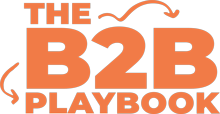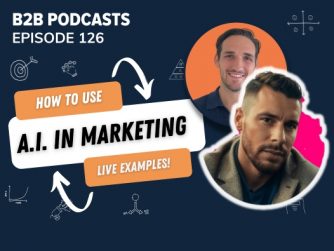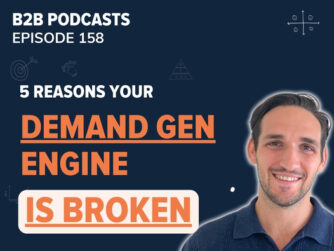If you’re a CMO, CRO or Head of Sales, you should be asking yourself: how can our teams work better together to drive more revenue, in a more efficient way?
We’ve come across so many organizations that have bloated methods for acquiring customers. They’re loaded to the brim with hungry SDRs who have ‘book the meeting at all costs’ as their mandate. They’ve handcuffed marketing and reduced them to ‘lead gen’ to feed the sales machine.
The result? A ‘spray and pray’ method that doesn’t work unless you have serious cash to burn. Marketing, sales and customer success are incentivised to behave in ways that compete with each other. A poor customer experience. And a high level of churn and dissatisfaction at customer success.
We cover the origins of this problem in pt.1 of our mini-series here.
Today we are sharing step 1 of our framework to create complete end-to-end organizational alignment. This is the solution to start driving a much more efficient acquisition system.
Step 1 is all about laying the foundations in place for your revenue engine before you go-to-market.
We’ll show you how to define your next best target customers by taking the following steps:
- 80/20 analysis to find your best customers
- interview them to understand your competitive advantage and how to influence them
- find more ‘best fit’ customers based on this criteria
- update your positioning and messaging
- catalogue the market to prioritize your next targets
As per usual, you can watch, listen to or read step 1 of our joint framework with sales expert Adem Manderovic below.
P.S. We cover every step in our framework in detail. Check it out below!
- Why sales-led growth is killing your business
- The foundations you need to create for your revenue engine
- How to build relationships of trust with prospects
- How to maximize your chances of winning deals
- How to reduce churn and expand revenue
Listen To The Episode
Watch The Episode
Overview of our 4 Step Process
We’re going to give you our 4 step process to laying the foundations for your revenue engine. These steps will show you HOW to get a deep understanding of your market (so you can influence it and win new business in the most efficient way). It will also show you the feedback loops you need between marketing and sales to do this.

Find Your Best Fit Customers
A huge reason companies struggle to consistently win new customers in a profitable way is that there isn’t a clear direction on who your ‘best customers’ are. This results in a lack of focus that means your business will always be a jack of all trades, but a master of none.
A jack of all trades does not produce amazing customer success stories, because it’s not set up to do anything extremely well. It also makes it difficult to stand out from the competition when you’re trying to win new business. You need a business to trust you before they buy from you. Bing a ‘master of none’ won’t do that!
That’s why our framework starts with defining who your business exists to serve. What segment of the market are you setup to service far better than the competition? So when this segment comes across your business, they think: “hell yeah, I’m in the right place. These people get me.”

Your company has limited time, budget and resources. Focus on your best customers. Find out what makes them such a great fit for your business. And then go and find more of them.
Use 80/20 Analysis to Find Your Best Fit Customers
One of our favourite ways to find best fit customers (which you will make your target segment) is to use 80/20 analysis. This analysis looks for the 20% of companies that are driving 80% of the desired output for the business.
What the ‘output’ is depends on the business’ priorities at its stage of growth. For some, the ‘output’ is revenue. For others, it is profitability. Make sure you align with leaders on where this focus should be, and what makes a customer a great customer.
Make a list of your best and worst customers based on this analysis. Write down exactly who they are. Then, you need to find out what they have in common so we can find more of them (or avoid the bad ones) in future.
A great way to do this is to pull out the firmographic, demographic and technographic qualities of these companies.
Deeply Understand and Document Your Customers
Now we’ve identified who our best customers are, we need to work hard to deeply understand why they chose you over the competition. The best way to do this is to conduct customer interviews, where you customers them a series of questions to determine:
- What makes them such a great fit for your business
- What the key benefits are
- What their buying journey looked like
- How your product/service fits into their jobs-to-be-done
- Who was involved in the buying decision and what was important to them
- Who influences their purchasing decisions
- Where they hang out online and offline
- What triggered their search for a product/service like yours
- What objections they had
This allows you to document what your Ideal Customers look like, along with a roadmap of what their typical buying journey looks like, all the questions they’ll have along the way, and where you need to be online and offline to influence them.

It is also a useful exercise to do this with customers who have churned or deals you lost to understand where you fell short, and any disqualification criteria – i.e. what makes someone a bad fit for your business.
Update Your Positioning and Messaging
After the previous exercise, you should have a deep understanding of what your best fit customers look like, and why they chose you over the competition.
That means it’s time to change your positioning and messaging to reflect that. The goal here is to make your Ideal Customers feel like you’re the perfect match for them when they have any interaction with your brand – be it your website, socials, presentations, resources, even the conversations and case studies shared by your sales teams.

This is exactly what Pipedrive have done to get a foothold in the extremely crowded CRM market. They positioned their business as the CRM for salespeople.

This differentiates themselves from Salesforce and Hubspot which have all the bells and whistles. If a sales-led team is looking for a CRM and they come across Pipedrive – it’s very easy to think, “hey, finally a CRM that understands me and my unique needs”.
That’s the feeling you need to achieve in this step.
Catalogue The Market and Prioritize It
At this stage, you should have defined who your best customers are, interviewed them to understand why they chose you over the competition, mapped their buying journey, repositioned yourself to be a ‘no brainer’ and perfect fit for your business, and created a list of future customers that would be a great fit for your business.
What should you do with this list of future customers? Who should you work on contacting and building relationships with first?

Adem Manderovic shared his old-school but extremely effective technique for prioritizing your list of future customers. It’s called cataloguing the market.
This splits out your target accounts from those who are ‘in-market’ vs those who aren’t yet so you know who to focus most of your efforts on first. Cataloguing the market is a great way to help do this.
So how do we find out which of these accounts are likely to be ‘in-market’ so you can prioritise them?
Sure, you can buy intent data from platforms like Bombora, but the validity of their data is questionable. Plus they’re not going to be able to tell you ‘insider’ information from each account to help you win that deal.
What is Cataloguing The Market?
In its most simple form, cataloguing the market is calling your target accounts, and asking them a series of questions to:
- understand if they’re in-market currently
- get a list of buying criteria and objections you can use to inform your marketing and sales to win the deal
This was a common technique used ‘pre-tech’.
How to Catalogue The Market?
Cataloguing the market requires you to call up your list of best fit accounts that you’d love to have as clients, and finding the answers to the following questions:
- Who are you with right now [for the existing service/product they use]?
- What do you like about it?
- Is there anything you don’t like about it?
- Are you in a fixed term contract for that?
These questions reveal what they currently use, what they value about it, and if there are any pain points with their existing solution. Also, understanding contractual commitments indicates when they may be going back out to tender or open to new options.
Adem also recommends you ask the following questions
- If you were going to tender, what would that tender need to contain?
- If you had the ability to change something with a magic wand, what would it be?
If you have this information, you know who is more likely to be in-market. You can also equip sales with what they need to talk about to make their contact as relevant as possible.
This is very different to the ‘spray and pray’ method that leads to organisational bloat, and a very negative experience for the customer.
You can read more on how to catalogue the market here.
Required Feedback Loops
For all of this to work, you need to have feedback loops in place between sales and marketing. Whoever catalogues the market and gathers feedback from existing and previous customers needs to pass it to the other team.
For example, the faster sales are able to communicate any ‘disqualification criteria’ (i.e. what makes someone a ‘bad fit’) to marketing, the faster they can update their campaigns and targeting to ensure we don’t attract those potential customers.

Another important point to communicate is to ensure that we are targeting potential customers that have a high enough revenue to justify the expense in acquiring and servicing them.
Adem shares a simplified version of this calculation for Annual Contract Value (ACV):
Actual user base / seats / talent x unit price
Complete alignment from marketing and sales on this ensures that deals don’t fall over at finance or legal. Or if they get through, to make sure they don’t churn at customer success.
Next Steps For You
Want to learn more about how to implement this in your business?
We have of course simplified the 5 step process for you here. The devil is (as always) in the details. If you’d like more information on how we can put this end-to-end growth system in place for your business, or train your team up internally to do this, please check out our end-to-end business growth engine program here.
P.S. We cover every step in our framework in detail. Check it out below!
- Why sales-led growth is killing your business
- The foundations you need to create for your revenue engine
- How to build relationships of trust with prospects
- How to maximize your chances of winning deals
- How to reduce churn and expand revenue








